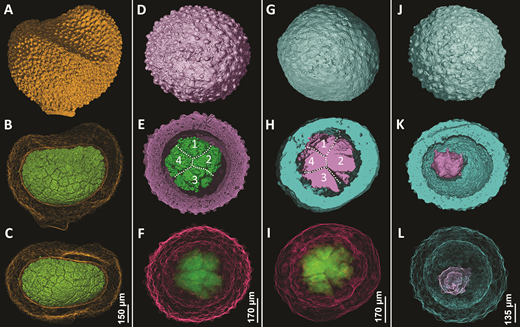quote=Michael V

Ediacaran-Cambrian boundary microfossils: animal diapause embryos (resting cysts) with internal cells preserved, shown by X-ray tomography.
Wow, Just Wow
quote=Michael V

Ediacaran-Cambrian boundary microfossils: animal diapause embryos (resting cysts) with internal cells preserved, shown by X-ray tomography.
Wow, Just Wow
mollwollfumble said:
quote=Michael V

Ediacaran-Cambrian boundary microfossils: animal diapause embryos (resting cysts) with internal cells preserved, shown by X-ray tomography.
Wow, Just Wow
Sorry, I forgot to reference the paper.
https://pubs.geoscienceworld.org/gsa/geology/article/46/5/387/528894/early-cambrian-animal-diapause-embryos-revealed-by
Michael V said:
mollwollfumble said:
quote=Michael V

Ediacaran-Cambrian boundary microfossils: animal diapause embryos (resting cysts) with internal cells preserved, shown by X-ray tomography.
Wow, Just Wow
Sorry, I forgot to reference the paper.
https://pubs.geoscienceworld.org/gsa/geology/article/46/5/387/528894/early-cambrian-animal-diapause-embryos-revealed-by
From paper:
“The fossils were collected from the lower Cambrian Kuanchuanpu Formation of the Hexi section in Xixiang County, Shaanxi Province, China. The fossils were recovered from limestone using acetic acid digestion (acid concentration of 3%) and manual sorting of the ensuing insoluble residue under a binocular microscope. Selected specimens were scanned at the Micro-CT Lab using a Zeiss Xradia 520 Versa. To achieve good contrast, we used a 50 kV operating voltage of the X-ray tube, with a thin filter (LE1) to avoid beam-hardening artifacts. Depending on the sizes of the specimens, two charge-coupled device (CCD)–based optical microscopes (4× and 20×) were applied. This system produces data sets with voxel dimensions ranging between 0.56 µm and 1.63 µm. The volume data were processed using VGSTUDIO MAX.”
Am jealous of that system. That’s something I’m itching to try myself. CSIRO has X-ray tomography, but with a coarse resolution near 0.5 mm. The acetic acid digestion technique was pioneered at the Sydney Museum.
“The virtual slices and 3-D reconstructions illustrate that the inner body has no cell structures, and is hollow with many small, later void-filling crystals inside”.
Like a blastocyst.
“the millimeter- and submillimeter-scale sizes of Archaeooides fall within the size range of living animal embryos, and overlap the size range of resting eggs of many aquatic invertebrates. Taken together, our data corroborate the hypothesis of an animal embryo interpretation of the enigmatic Archaeooides and suggest, further, that they represent the encysted diapause stage in the embryology of a Cambrian metazoan.”
I needed to look up “diapause”.
“Embryonic diapause – a period of embryonic suspension at the blastocyst stage – is a fascinating phenomenon that occurs in (arthropods, some fish and) over 130 species of mammals, ranging from bears and badgers to mice and marsupials. It might even occur in humans. During diapause, there is minimal cell division and greatly reduced metabolism, and development is put on hold. Yet there are no ill effects for the pregnancy when it eventually continues. … how do the blastocysts survive and remain viable during this period of time, which can be up to a year in some cases? And what are the signals that bring it out of suspended animation?” from http://dev.biologists.org/content/144/18/3199
mollwollfumble said:
Michael V said:
mollwollfumble said:
quote=Michael V

Ediacaran-Cambrian boundary microfossils: animal diapause embryos (resting cysts) with internal cells preserved, shown by X-ray tomography.
Wow, Just Wow
Sorry, I forgot to reference the paper.
https://pubs.geoscienceworld.org/gsa/geology/article/46/5/387/528894/early-cambrian-animal-diapause-embryos-revealed-by
From paper:
“The fossils were collected from the lower Cambrian Kuanchuanpu Formation of the Hexi section in Xixiang County, Shaanxi Province, China. The fossils were recovered from limestone using acetic acid digestion (acid concentration of 3%) and manual sorting of the ensuing insoluble residue under a binocular microscope. Selected specimens were scanned at the Micro-CT Lab using a Zeiss Xradia 520 Versa. To achieve good contrast, we used a 50 kV operating voltage of the X-ray tube, with a thin filter (LE1) to avoid beam-hardening artifacts. Depending on the sizes of the specimens, two charge-coupled device (CCD)–based optical microscopes (4× and 20×) were applied. This system produces data sets with voxel dimensions ranging between 0.56 µm and 1.63 µm. The volume data were processed using VGSTUDIO MAX.”
Am jealous of that system. That’s something I’m itching to try myself. CSIRO has X-ray tomography, but with a coarse resolution near 0.5 mm. The acetic acid digestion technique was pioneered at the Sydney Museum.
“The virtual slices and 3-D reconstructions illustrate that the inner body has no cell structures, and is hollow with many small, later void-filling crystals inside”.
Like a blastocyst.
“the millimeter- and submillimeter-scale sizes of Archaeooides fall within the size range of living animal embryos, and overlap the size range of resting eggs of many aquatic invertebrates. Taken together, our data corroborate the hypothesis of an animal embryo interpretation of the enigmatic Archaeooides and suggest, further, that they represent the encysted diapause stage in the embryology of a Cambrian metazoan.”
I needed to look up “diapause”.
“Embryonic diapause – a period of embryonic suspension at the blastocyst stage – is a fascinating phenomenon that occurs in (arthropods, some fish and) over 130 species of mammals, ranging from bears and badgers to mice and marsupials. It might even occur in humans. During diapause, there is minimal cell division and greatly reduced metabolism, and development is put on hold. Yet there are no ill effects for the pregnancy when it eventually continues. … how do the blastocysts survive and remain viable during this period of time, which can be up to a year in some cases? And what are the signals that bring it out of suspended animation?” from http://dev.biologists.org/content/144/18/3199
:)